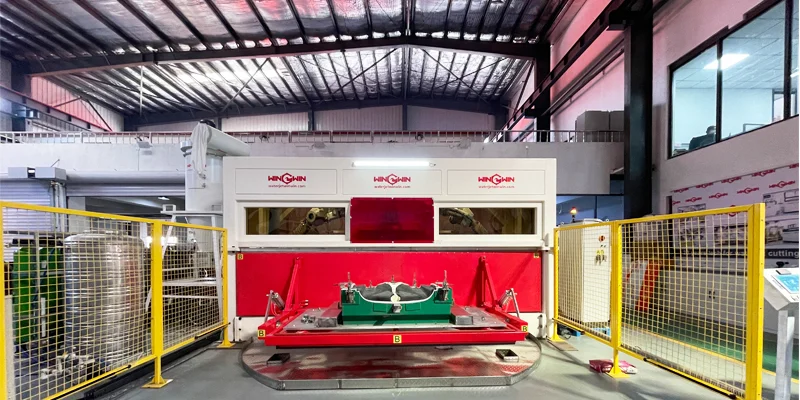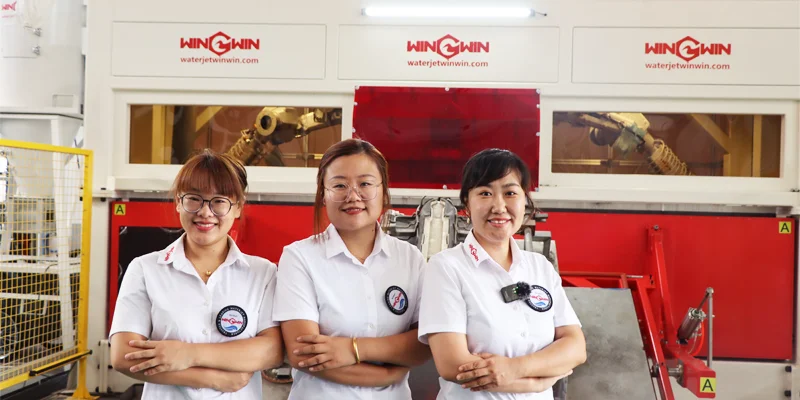ROBOTIC WATERJET CUTTING TECHNOLOGY
Robotic waterjet Cutting routines for complicated 3D shapes , it would be impossible to punch can easily be programmed with the robot.
The flexibility of Win-Win’s Robotic waterjet cutting systems enable manufacturers to make the most of their capital investment. Trimming programs can easily be changed or added so that several parts can be cut on the same system with virtually no set-up time.
The high-pressure Robotic waterjet is used as a tool to cut a wide range of materials. Win-Win waterjet is very powerful, with cutting speeds between 100 and 500 mm/s for a variety of automotive carpets and from 300 to 500 mm/sec for headliners. The speed of the waterjet and robot allow the cutting material to remain almost completely dry.
Win-Win Robotic Waterjet cutting Technology is available in multiple cutting and trimming options
1. water-only and abrasive robot trimming
2. Pedestal and Ceiling structure.
What are the different types of Robotic waterjet Cutting?
Classified according to application areas:
Industrial Cutting: mainly used in industrial manufacturing fields, such as metal processing, automobile manufacturing, etc. In these applications, waterjet can be used to cut metals, plastics, composites and other materials.
Stone Cutting: used in stone processing fields, such as construction, sculpture, etc. Water cutting can accurately cut marble, granite and other stone materials.
Glass Cutting: used in glass processing fields, such as glass products, architectural glass, etc. Waterjet cutting can cut glass with high precision to avoid breakage and cracks.
Other applications: There are also Robotic waterjet Cutting applications in specific fields, such as food processing, medical equipment, etc.
Classification according to frame structure
Ceiling type
Pedestal type

Overview of pedestal Robotic waterjet Cutting
This type of robotic system is typically used to cut larger sizes, complex shapes, or heavier materials.
The following are the general features and functions of pedestal Robotic waterjet Cutting:
Robot structure: The pedestal Robotic waterjet Cutting machine consists of a mechanical structure, a control system and water cutting equipment. Mechanical structures usually include robot arms, coils, filters, etc., which can achieve movement with multiple degrees of freedom.
The control system is responsible for receiving the operator’s instructions and converting them into movement commands for the robot. pedestal Robotic waterjet Cutting is the end effector of the robot, responsible for spraying high-pressure water flow and abrasive mixture for cutting.
Large-size cutting
pedestal Robotic waterjet Cutting machine usually have a larger working range and load-bearing capacity and can handle larger-size materials. This makes them suitable for cutting large plates, structural members, marine components, etc.
Precise Cutting
Waterjet technology is highly precise and repeatable, allowing for fine cutting contours and high-quality cutting edges. The seated waterjet cutting robot can achieve precise positioning and cutting control through the control system and high-precision sensors.
Automation function
Some pedestal Robotic waterjet Cutting have automation functions and can automatically cut according to preset programs and paths. This reduces operator workload and increases productivity.
Safety considerations
Water cutting is a non-thermal cutting method with no open flames and heat radiation, thus reducing the risk of fire and smoke.
In addition, robot systems usually have safety protection devices, such as emergency stop buttons, anti-collision sensors, etc., to ensure the safety of the operator.
This type machine used in construction, manufacturing, aerospace, automotive and other fields to cut various materials such as metal, composite materials, stone, glass and so on. They provide efficient, precise and safe cutting solutions for complex cutting needs.

Overview of Ceil type Robotic waterjet Cutting
The following is the general workflow of Ceiling type Robotic waterjet Cutting machine
Material preparation
First, the material to be cut needs to be prepared. This can be flat materials such as metal sheets, plastic sheets, stone, etc.
Ceiling installation
Install the waterjet cutting robot on a suspended ceiling system. Suspended ceiling systems often have adjustable heights that can be adjusted as needed to accommodate different thicknesses of materials.
Material fixation
Place the material to be cut on the work area and use clamps or other fixtures to hold it stably in place. This ensures that the material does not move or wobble during the cutting process.
Cutting settings
Set the cutting parameters of the machine, such as cutting speed, cutting pressure, cutting path, etc. These parameters can be adjusted according to material type and requirements.
Cutting operation
Start the robot, which will cut from the top of the ceiling system downwards according to the predetermined program and path. Ceiling type machine cut materials by spraying a high-pressure water stream and abrasive mixture to form the desired cutting profile.
Ceiling type Robotic waterjet Cutting machine has the following advantages:
Flexibility
Because the cutting robot operates from above, it can handle larger sized materials regardless of the size limitations of the robot itself.
Accuracy
Waterjet technology is highly precise and repeatable, allowing for fine cutting profiles and high-quality cutting edges.
Safety
Ceiling type machine is a non-thermal cutting method with no open flames and heat radiation, thus reducing the risk of fire and smoke.
No pollution
no harmful gases or waste materials are produced during the water cutting process, which is environmentally friendly.
Ceiling type machine is widely used in construction, decoration, manufacturing and other fields, and is especially suitable for flat materials that require high-precision cutting.

 wwaterjet
wwaterjet